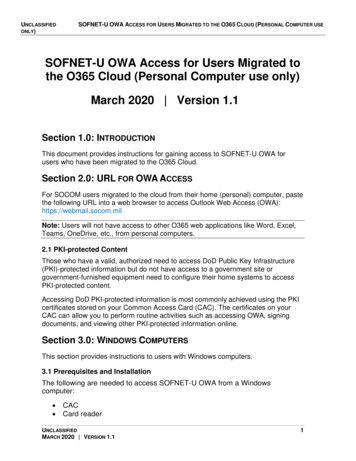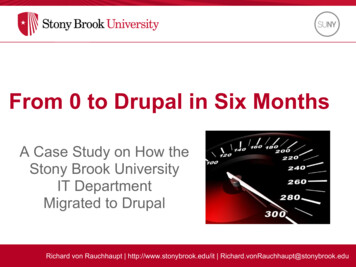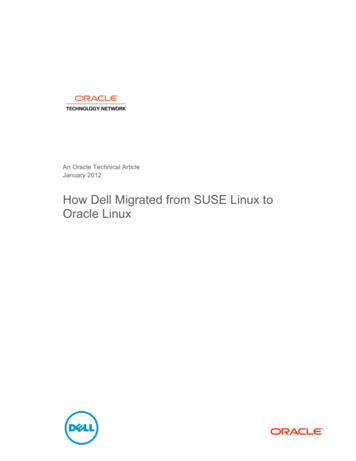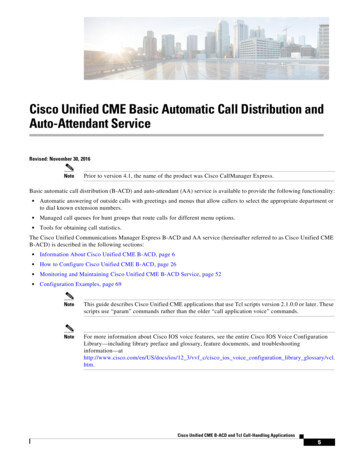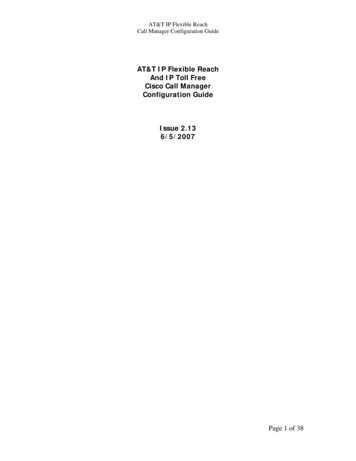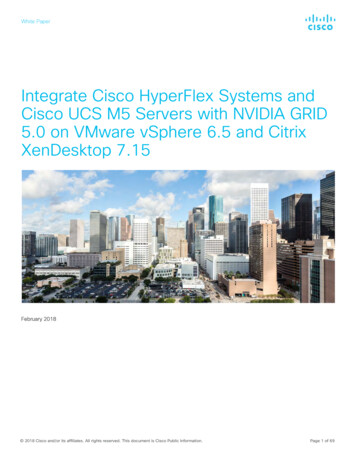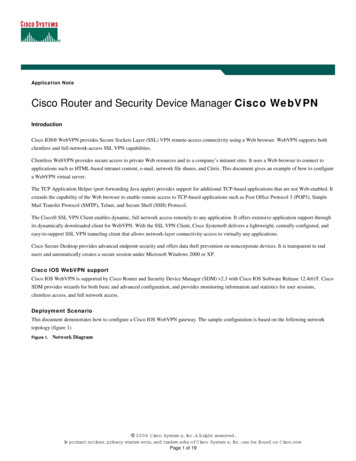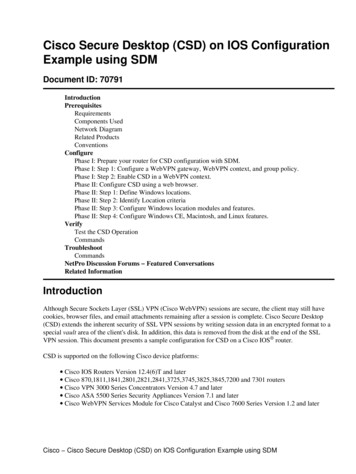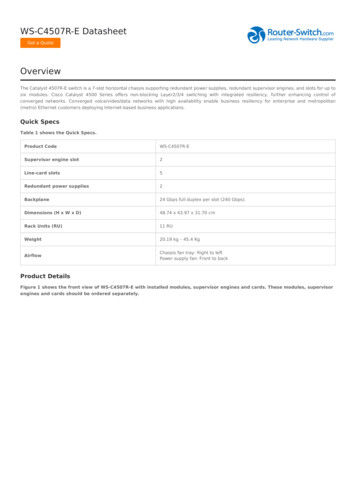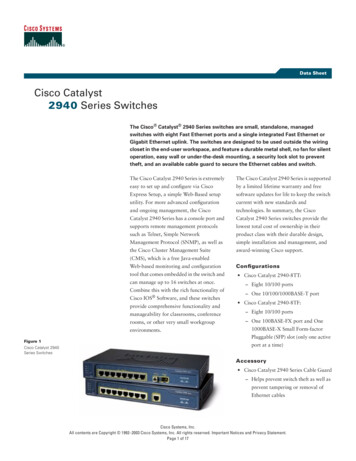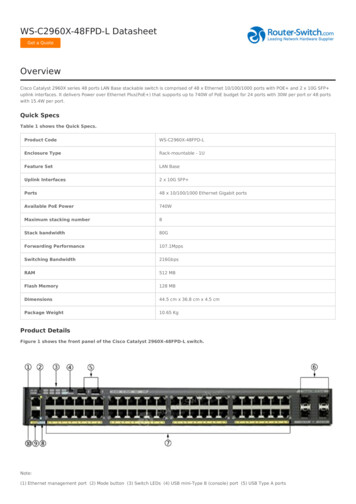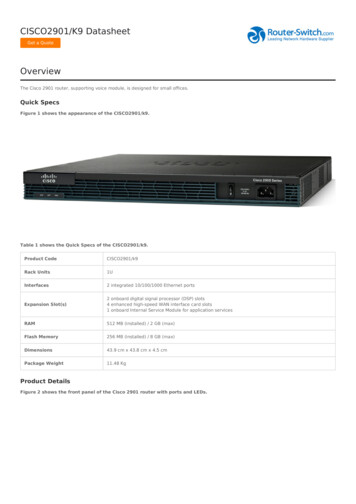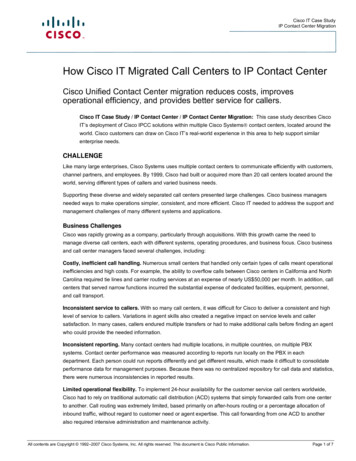
Transcription
Cisco IT Case StudyIP Contact Center MigrationHow Cisco IT Migrated Call Centers to IP Contact CenterCisco Unified Contact Center migration reduces costs, improvesoperational efficiency, and provides better service for callers.Cisco IT Case Study / IP Contact Center / IP Contact Center Migration: This case study describes CiscoIT’s deployment of Cisco IPCC solutions within multiple Cisco Systems contact centers, located around theworld. Cisco customers can draw on Cisco IT’s real-world experience in this area to help support similarenterprise needs.CHALLENGELike many large enterprises, Cisco Systems uses multiple contact centers to communicate efficiently with customers,channel partners, and employees. By 1999, Cisco had built or acquired more than 20 call centers located around theworld, serving different types of callers and varied business needs.Supporting these diverse and widely separated call centers presented large challenges. Cisco business managersneeded ways to make operations simpler, consistent, and more efficient. Cisco IT needed to address the support andmanagement challenges of many different systems and applications.Business ChallengesCisco was rapidly growing as a company, particularly through acquisitions. With this growth came the need tomanage diverse call centers, each with different systems, operating procedures, and business focus. Cisco businessand call center managers faced several challenges, including:Costly, inefficient call handling. Numerous small centers that handled only certain types of calls meant operationalinefficiencies and high costs. For example, the ability to overflow calls between Cisco centers in California and NorthCarolina required tie lines and carrier routing services at an expense of nearly US 50,000 per month. In addition, callcenters that served narrow functions incurred the substantial expense of dedicated facilities, equipment, personnel,and call transport.Inconsistent service to callers. With so many call centers, it was difficult for Cisco to deliver a consistent and highlevel of service to callers. Variations in agent skills also created a negative impact on service levels and callersatisfaction. In many cases, callers endured multiple transfers or had to make additional calls before finding an agentwho could provide the needed information.Inconsistent reporting. Many contact centers had multiple locations, in multiple countries, on multiple PBXsystems. Contact center performance was measured according to reports run locally on the PBX in eachdepartment. Each person could run reports differently and get different results, which made it difficult to consolidateperformance data for management purposes. Because there was no centralized repository for call data and statistics,there were numerous inconsistencies in reported results.Limited operational flexibility. To implement 24-hour availability for the customer service call centers worldwide,Cisco had to rely on traditional automatic call distribution (ACD) systems that simply forwarded calls from one centerto another. Call routing was extremely limited, based primarily on after-hours routing or a percentage allocation ofinbound traffic, without regard to customer need or agent expertise. This call forwarding from one ACD to anotheralso required intensive administration and maintenance activity.All contents are Copyright 1992–2007 Cisco Systems, Inc. All rights reserved. This document is Cisco Public Information.Page 1 of 7
Cisco IT Case StudyIP Contact Center MigrationLimited knowledge sharing. The existing ACD systems did not support the knowledge base that agents needed,such as automatic information displays (“screen pops”), or monitoring tools for the call center managers.Technical ChallengesCisco IT’s goal was to bring new technology to the call centers, while implementing standards that would reducecosts, improve service, and increase operational efficiency. To accomplish this, Cisco IT faced several technicalchallenges:Lack of standards. Overall, there was no reasonable methodology for simplifying call center processes, using callcenter agents and resources to handle multiple call types, or easily outsourcing call center functions. Differentreporting capabilities and terminology made it difficult to consistently measure service levels and agent performanceacross all Cisco call centers.Migration to Cisco solutions. A corporate goal at Cisco is to use the company’s own products wherever possible inthe network, IT environment, and business operations. For the call centers, this meant replacing the traditional PBX,ACD, and interactive voice response (IVR) systems, as well as numerous applications for call handling and callcenter management.Franklin King, a Cisco IT engineer, summarizes the business and technical challenges: “We saw a lot of needs, bothinternally and externally. We needed to apply economies of scale and consistent technology across all call centers.We needed to route calls on an enterprise level instead of to single buildings. And, we needed a way to get calls tothe agents who could solve the problem on the first try.”SOLUTIONCisco IT was a major participant in the extensive effort to implement a multi-phase, multi-year plan for improving thecall centers. One goal of this plan was to use Cisco network and call processing technologies: the Cisco IntelligentContact Management (ICM) system and, in a later phase, the Cisco IP Contact Center (IPCC) solution.Phase 1: Integrating Cisco Call Centers, Implementing New SystemsPhase 1 of the plan for the call center migration, launched in 1999 and completed in 18 months, focused on threeinitiatives that would take advantage of the intelligence in the Cisco enterprise network: Enhance the existing “follow the sun” (24-hour) model for call routing while minimizing ongoing maintenance.Based on real-time agent statistics, improve global call routing and decrease call routing costs, whiledelivering a more consistent caller experience in all Cisco call centers. Implement call routing capabilities to help a caller connect with the right agent on the first attempt. Thesecapabilities encompassed pre-routing within the service provider network and re-routing after the Cisco ICMreceived the call. Combine traditional, time division multiplexing (TDM)-based ACD and PBX systems into a fully redundantarchitecture that would reduce transport and support costs, and also would reduce dependency on serviceproviders to achieve flexibility in call handling.“Our traditional voice system had ‘look ahead’ capabilities that provided a certain amount of intelligent routing, but itwas expensive to use those features,” says Scott Fairman, an infrastructure engineer for Cisco IT. “We actuallyeliminated many of the costs of call routing by integrating our call centers and making our call handling architecturemore efficient.”Cisco ICM delivered a number of valuable features for the goals of Phase 1: True load sharing across Cisco call centers with the ability to control routing before and after the call enteredthe Cisco internal network, including definitions of contingency and default routing. Continued support for a mixed-vendor ACD environment while beginning the migration to Cisco call centerAll contents are Copyright 1992–2007 Cisco Systems, Inc. All rights reserved. This document is Cisco Public Information.Page 2 of 7
Cisco IT Case StudyIP Contact Center Migrationproducts. An enterprisewide view for real-time and historical reporting on activity in all Cisco call centers. Automated call routing to different centers around the world to deliver 24-hour availability of importantfunctions, such as customer service.An important Cisco ICM feature for combining the operations of separate call centers is the use of customizable,flexible scripts for call routing. These scripts reflect Cisco business rules and route each call to the best agent basedon the call topic or the availability of agents with a particular language, skill, or other factor. Wherever an agent isbased, the Cisco ICM system delivers the call and supporting customer and call data, which are drawn from a centraldatabase.To complete each transaction, Cisco ICM profiles the customer using contact-related data such as dialed number andcalling-line ID, caller-entered digits, data submitted on a Web form, or information obtained from a database lookup ofthe customer profile.“Using Cisco ICM, we could route calls to different locations with better variables,” says King. “We also gainedvisibility within each of our existing PBXs, including the number of agents, the number of calls, and activity reports.Based on that data, we wrote new routing rules so that calls would be answered more quickly and the workload wouldbe distributed appropriately.” Cisco ICM also enabled external outsourcing companies to integrate their PBX systems,of multiple types, with the Cisco ICM system for improved, real-time call routing and standardized reporting throughCisco WebView.The Phase 1 implementation of Cisco ICM also yielded valuable information for Cisco call center managers. “At theend of Phase 1, every agent in the integrated call centers was visible in a single database, along with customercontact and case information,” says Cindy Mike, a Cisco program manager. “This information was available to Ciscomanagers around the globe, which helped them to make better decisions about call center operations.”Figure 1.The Cisco ICM call routing capabilities enable distribution of traffic to multiple Cisco contact centers worldwide, basedon Cisco-defined routing rules.Salt Lake sBrusselsNew DelhiBeijingHerndonChengduRTPSan BangaloreSydneySao PauloSingaporeBuenos AiresInternal Cisco IPCCRemote Agents located in a Cisco officeOutsourced LocationsStandalone Cisco LocationsAll contents are Copyright 1992–2007 Cisco Systems, Inc. All rights reserved. This document is Cisco Public Information.Page 3 of 7
Cisco IT Case StudyIP Contact Center MigrationPhase 2:Migrating to IP Telephony with Cisco IPCCPhase 2 implementation for the call center migration plan began in 2002. The goals for this phase includedeliminating the remaining inconsistencies in call handling, increasing the use of Web tools for knowledge capture, anddeploying IP-based systems to replace the TDM-based PBX, ACD, and IVR systems as well as agent phones.The Phase 2 technology architecture included Cisco CallManager for call processing, Cisco ICM to control callrouting, Cisco IP IVR to control call queuing, Cisco WebView software for reporting, and Cisco Computer TelephonyIntegration Object Server (CTI OS) Agent Desktop software for agent control of answered calls. The Cisco WebViewtool allows company managers to efficiently report all performance data for all contact centers globally, eliminatingthe need to compile numerous and varied local reports. Cisco WebView also provides consistency in report contentsby maintaining a central database.“Phase 2 required a fast schedule for migrating 13 sites from TDM systems to the complete Cisco IPCCinfrastructure,” says Fairman. The project team assessed the needs of the diverse Cisco call center groups and thedifferent business and cultural considerations for locations around the globe. Most groups were housed in standalonecall centers, but the Cisco headquarters site in San Jose, California accommodated 15 different call groups.As part of this assessment, the project team determined which call centers served customers and which served onlyemployees; in addition, which call centers had activity that could be contained within a single site and which groupssupported global operations in multiple locations. The assessment also identified agent skill sets—from corporateoperators who handle general inquiries, to the Cisco Technical Assistance Centers (TACs) that are staffed byengineers.The project team found other challenges in preparing for Phase 2. In the traditional PBX environment, agents wereaccustomed to handling calls by pressing buttons on the phones. In this phase, agents migrated to the Cisco CTI OSAgent Desktop software, which controls softphone functions through a screen display on an agent’s computer.At the end of Phase 2, Cisco IPCC was implemented in 10 locations, connecting nearly 800 agents and handlingapproximately 100,000 calls per month. The call centers were using nearly 40 new applications, including CiscoWebView for managing reports.“By using the flexible routing capabilities of the Cisco network and Cisco contact center technologies, we havesubstantially reduced toll charges while making our operations more efficient and giving better service to callers.”—Mary Mazon, Cisco IT engineerPhase 2 was defined as a corporate initiative, with a challenging goal of a six-month deployment schedule. Throughcareful planning and a team that quickly applied the lessons learned at each step, the deployment was completed inseven months—still considered a rapid pace. “We learned in the early sites how we should design the migration tasksand applications, and that helped us to deploy the systems faster in the later sites,” says Fairman.All contents are Copyright 1992–2007 Cisco Systems, Inc. All rights reserved. This document is Cisco Public Information.Page 4 of 7
Cisco IT Case StudyIP Contact Center MigrationFigure 2.Cisco contact center solutions are integrated in the Cisco environment for efficient call handling while meeting thebusiness needs of each contact center.Phase 3: Implementing Cisco LivePhase 3 of Cisco’s plan for call center migration delivered the CiscoLive application, which allows a customer to clickon a Web link to request a callback from a Cisco agent. CiscoLive also provides interaction tools such as URLsharing, form sharing, and text chat, which help the agent and customer collaborate in a Web session while talking onthe
Overall, there was no reasonable methodology for simplifying call center processes, using call center agents and resources to handle multiple call types, or easily outsourcing call center functions. Different reporting capabilities and terminology made it difficult to consistently measure service levels and agent performance across all Cisco call centers. Migration to Cisco solutions. A .
